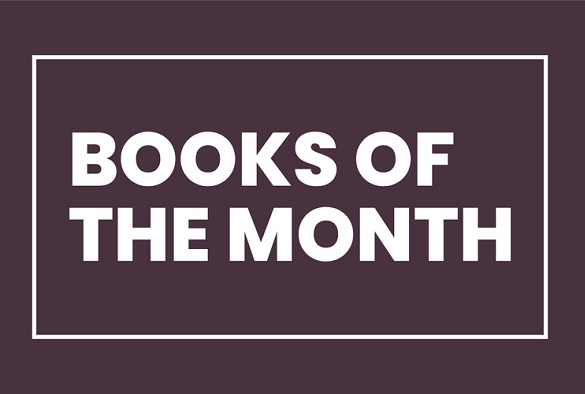Books of the Month: July
Published on

Wherever you are in the world and whatever you're interested in, our ‘Books of the month’ features a broad sample of different recent releases authored by University of Liverpool staff. From architecture to business, photography to tourism, there’s something for everyone.
The University of Liverpool Library has curated a reading list for Book of the Month which is available and searchable for University of Liverpool staff and students. The newest titles are added at the top of the list for visibility, and further information can be found in the notes area.
If you are a member of UoL staff and would like your new or recent (2023, 2024 & 2025) publication to be featured, please email the details to the Research Communications Team at rescomms@liverpool.ac.uk.
***

An Introduction to the Physics of Nuclear Medicine (Second Edition)
Author: Laura Harkness-Brennan
Published: 2024
Nuclear medicine is a medical speciality involving the application of radioactive substances in the diagnosis and treatment of disease. Procedures that involve the production and administration of radionuclides to the body for either diagnostic or therapeutic purposes fall under the remit of this field. This course text provides an introduction to key topics in nuclear medicine, from the fundamental principles of radioactivity through to the production and use of radionuclides for diagnostic and therapeutic procedures. New to the second edition is a chapter on the use of Monte Carlo methods in nuclear medicine, new sections on machine learning and intraoperative nuclear probes and recent updates about novel radiopharmaceutical production. The book can be used as an informative supplement in general physics undergraduate programmes and master’s postgraduate level medical physics. Part of IPEM–IOP Series in Physics and Engineering in Medicine and Biology.
Laura Harkness-Brennan is a Professor in the Department of Physics and Associate pro-Vice Chancellor for Research and Impact for the Faculty of Science and Engineering, at the University of Liverpool.
***

Aesthetics and Counter-Aesthetics of International Justice
Authors: Christine Schwöbel-Patel and Robert Knox
Published: 2024
In recent years, growing attention has been paid to the relationship between international law and aesthetics. This collection situates this relationship within its wider political context, demonstrating that the question of aesthetics in not neutral but rather connected to the social, economic, and political relationships in which international justice is deeply embedded. The first part of the collection is an invitation to reflect on what we see and register in international justice, in particular in representations of those who suffer violence, including the violence of law. The second part of the collection uses different forms to reflect on how aesthetics can be turned against the dominant aesthetics and politics of international law, in the form of ‘counter-aesthetics’ through cartoons, interviews, parables, and a screenplay. This collection is the first of its kind to make visible the dominant and normalized aesthetics of violence and justice through a political economy lens; and to take seriously the limitations of the aesthetic forms that give violence and justice their expression.
Christine Schwöbel-Patel, previously at University of Liverpool 2011-2018, is Professor of Law at the University of Warwick, Alexander von Humboldt Fellow, and co-Director of the Centre for Critical Legal Studies.
Robert Knox is a Senior Lecturer in Law at the University of Liverpool, and an editor of ‘Historical Materialism: Research in Critical Marxist Theory’ and the ‘London Review of International Law’.
***

‘To See a World in a Grain of Sand’: Glass from Nubia and the Ancient Mediterranean
Author: Juliet V. Spedding
Published: 2023
Using modern scientific methods, this book examines glass beads and vessel fragments dating from the Meroitic and Early Nobadia periods, providing a new assessment of glass from Nubia. Results reveal interrelationships between trade, technological understanding, and manufacturing choices across the cultures of Sudan, Egypt and the Mediterranean.
‘To See a World in a Grain of Sand’ uses modern scientific methods to examine glass beads and vessel fragments dating from the Meroitic (c. 350 BC-AD 350) and Early Nobadia (c. AD 350-600) periods to provide a new assessment of glass from Nubia (ancient Sudan), a subject hitherto little-studied. The resulting identification of their chemical makeup is not simply about artefact reclassification but permits the tracking of similar compositions and—by extension—the raw materials for glass production that were used throughout Nubia, Egypt, and the Mediterranean. The results reveal interrelationships between trade, technological understanding, and manufacturing choices made across these cultures. Comparing glasses from Nubia with those from Egyptian and Mediterranean contexts has also shown how the same primary production centres were providing glass to sites in Turkey, Albania, Egypt, and Nubia. The identification of different glass groups and rare types of glass within Nubia shows the extent and variation to be found in a material that is present not only at a single site but also across the whole region, while the data presented reveals the diverse and complex nature of glass objects discovered there. That multiple interactions were being employed in glass manufacture shows how the examination of artefacts and their component materials must include consideration of both international trade and ‘home-based’ practices.
Juliet V. Spedding is a postdoctoral research associate on the Leverhulme Trust funded project Biodiversity in Egyptian Archaeology during Societal Transitions (BEAST) which spans two departments of the university, Archaeology, Classics, and Egyptology (ACE) and Evolution, Ecology and Behaviour (DEEB).